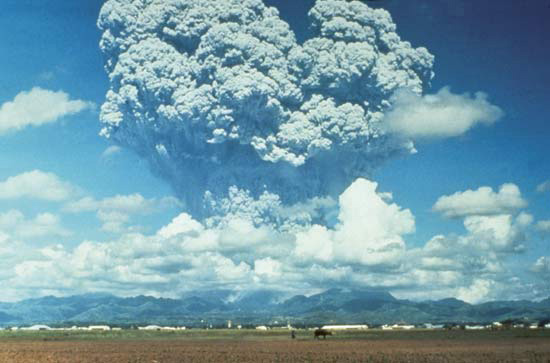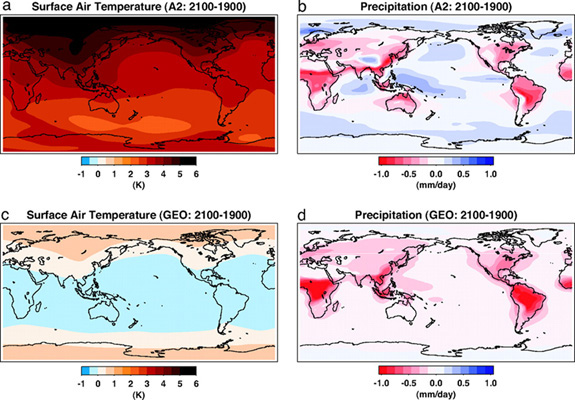

by Dan Armstrong
Mount Pinatubo on the island of Luzon in the Philippines erupted several times in June of 1991. In total, it ejected ten cubic kilometers of volcanic debris, making it the second largest volcano of the 20th century and ten times larger than the 1980 eruption of Mount St. Helens. The cloud of volcanic ash covered 125,000 square kilometers and drifted as far north as Vietnam and as far south as Malaysia. Along with the explosion of magma and ash, the eruption released 17 million tons of sulfur dioxide (S02 gas), creating a global layer of sulfuric acid haze that remained in the stratosphere for three years. Because of the reflective qualities of sulfate gases, the amount of sunlight reaching the Earth's surface during that time was reduced by five percent, leading to a decrease of .5-.6 degrees Celsius in surface air temperatures in the northern hemisphere and .4 degrees for the entire globe. Such was the significance of these effects, climate scientists and geoengineers immediately began to study the event, wondering if intentionally injecting sulfates into the atmosphere could be a credible way of counteracting global warming.

It's been fifty years since Roger Revelle and Hans Suess of California's Scripps Institute of Oceanography published their landmark paper confirming that the atmosphere, not the ocean, was the Earth's most important carbon sink. This research paper marked the unofficial opening of the global warming debate, a debate that for all intents and purposes ended this winter with the publishing of the Intergovernmental Panel on Climate Change's latest conclusions: Climate Change is real; it has been caused by human activities, primarily the burning of fossil fuels; and it holds the potential to impact every living thing on the planet.
While these findings were already well documented in the scientific community twenty years ago, when containing the problem was much more feasible, it was not acted on for a variety of reasons, many connected to the encompassing part fossil fuels play in the global economy and the political influence of the oil industry. In recent years, however, as the effects of the warming trend have become increasingly evident, receding glaciers, lost polar ice mass, coral reef erosion, insect migrations, serious, though belated, discussion has become part of the public and political dialogue, underscored by one rather disturbing fact: time-lags associated with the effects of greenhouse gases will cause the warming to continue for another 50 to 100 years no matter how we change the way we live. Even were we able to accept the economic costs of cutting our fossil fuel usage by fifty percent or more, which will not happen in any kind of meaningful time frame, it would still be difficult, in not impossible, to stop what has already been put in motion. Add to this the increasing concern that positive feedback loops in the warming trend may bring on climate changes more rapidly and with far more devastating effects than previously imagined and suddenly ideas that were once considered farfetched or impossible are now back on the table. At the top of the list is intentionally modifying the climate to counteract the effects of greenhouse gases through geoengineering, mostly likely some manner of reducing incoming solar radiation, either space-based reflectors, seeded cloud cover, or the injection of sulfate aerosols into the stratosphere in an effort to duplicate the cooling effects of the Mount Pinatubo eruption.
Modifying the climate in any way has always been a controversial idea, both for the scale of the operations involved and the complexity of the side-effects even slight changes can produce. Difficulties associated with ways to test or experiment with the implementation and effectiveness of geoengineering in the field add to the problem, tasking climate scientists to find methods to evaluate the feasibility of climate modification through computer modeling. Researchers Ken Caldeira and H. Damon Matthews at the Department of Global Ecology in Stanford, California recently did just this, using a computer to simulate the effects of intentionally reduced solar radiation (solar forcing) on the global climate system. Their results were published in the June 11th, 2007 Proceedings of the National Academy of Sciences under the title "Transient Climate–Carbon Simulations of Planetary Geoengineering." A brief review of this paper is helpful in evaluating state-of-the-art geoengineering.
Though models have been used before to study the effects of solar forcing, Matthews and Caldeira's computer simulation is a significant upgrade. Unlike previous simulations, their model was able "to capture the time-dependent implications for the climate system in a world subject to both continued carbon dioxide emissions and large-scale geoengineering," including for the impact of temperature and carbon dioxide concentration on natural carbon cycles and global precipitation. The analysis involved eleven computer simulations run for the time period 1900 to 2100. All runs were based on a business as usual carbon emissions scenario, which the researchers projected to be an increase of atmospheric carbon dioxide concentrations from 280 ppm in 1900 to 880 ppm in 2100. One run (A2 in figure below) contained no human initiated reduction of solar radiation. Four runs included for geoengineered solar forcing begun in the years 2000 (GEO in figure below), 2025, 2050, and 2075 and maintained through 2100. Three runs included geoengineered solar forcing begun in 2000 with an abrupt cessation of geoengineering in 2025, 2050, and 2075. And three runs were made with climate sensitivity to carbon dioxide doubled–one with no geoengineering, one with geoengineering, and one where the geoengineering was abruptly terminated in 2050.
The model showed that without any geoengineering surface air temperatures on the Earth would increase an average of 3.5 degrees Celsius by 2100, with a 2.5 degree increase in the South Pacific and a more than 5 degree increase in the high northern latitudes. When geoengineered solar forcing was initiated in the year 2000, average air temperatures for the year 2100 remained very close to 1900 levels, actually decreasing .35 degrees Celsius in the tropical Pacific and increasing less than 1.0 degree in the Arctic.
The model also revealed equally significant changes in global precipitation patterns. The simulation that included for no geoengineering showed a slight global precipitation decrease of .02 mm per day, with a modest increase in precipitation over the oceans caused by the higher global temperatures and a nearly equal decrease in precipitation over the land, attributed to "the effect of increased carbon dioxide levels on plant photosynthesis, whereby plants use soil water more efficiently and evapotranspiration is reduced." With solar forcing, average precipitation decreased .18 mm per day, with essentially all of the loss over the land (carbon dioxide driven), where it would be needed most, and no change over the oceans (because surface air temperatures did not appreciably increase when geoengineering was used).

In runs where solar forcing was initiated in 2025, 2050, or 2075, all surface air increases due to greenhouse gas effects were eliminated relatively quickly, less than 10 years. In simulations where geoengineering was abruptly terminated, however, the results were not so sanguine due to critical changes in the dynamics of the Earth's carbon cycles.
Natural carbon sinks decrease in efficiency with rising temperatures and increase in efficiency with increased carbon dioxide concentrations. For "business as usual" carbon emission scenarios with no geoengineering, temperature changes out weigh carbon dioxide concentration changes in overall carbon absorption efficiency, creating a net carbon absorption decrease, meaning another positive warming feedback loop to add to ice mass loss and thawing permafrost methane release. Solar forcing with "business as usual" emissions, however, minimizes surface air temperature changes while carbon dioxide concentrations continue to climb. This allows natural carbon sinks to increase in efficiency without the decrease associated with rising temperature, generating a greatly welcomed negative feedback loop. Unfortunately, "this temporary suppression of climate-carbon cycle feedbacks," write Matthews and Caldeira, "combined with the rapid adjustment of the climate system to changes in solar forcing, could lead to severe climate consequences in the case of abrupt termination or failure of the geoengineering scheme." When the model was run with an abrupt termination of solar forcing, global temperatures rebounded rapidly to where they would have been without any geoengineering–at a rate of 4 degrees Celsius per decade!–twenty times the current rate of .02 degrees Celsius per decade. In other words, abrupt cessation creates a situation worse than what existed prior to the geoengineering effort.
All of this is noteworthy to understanding both the dynamics of the global climate system and the pluses and minuses of geoengineered solar forcing. Caldeira and Matthews' computer simulations showed that intentionally decreasing solar radiation can counteract greenhouse gas warming. Also that it works reasonably quickly, "hence, there may be little costs to delaying the deployment of geoengineering strategies until such a time as 'dangerous' climate change is imminent." These positives are balanced by cautions voiced about abrupt geoengineering failures, added decreases in precipitation over land masses near the equator, the continued acidification of the oceans (because solar forcing allows carbon dioxide levels to increase), and "unresolved concerns that geoengineering proposals involving sulfate aerosols may have negative consequences on stratospheric ozone levels."
Overall, the authors make their position on geoengineering very clear: "Decreasing emissions of greenhouse gases reduces the environmental risk associated with climate change. By contrast, continued carbon dioxide emissions, even with the potential of geoengineering, will likely increase environmental risk. Thus, with respect to environmental risk, geoengineering is not an alternative to decreased emissions." They go on to say that while geoengineering should not be considered "a viable alternative to mitigation efforts aimed at reducing greenhouse gas emissions, it may prove to be a necessary last resort to prevent dangerous changes in the event that future climate warming is larger than anticipated. It is possible, however, that increased anthropogenic interference in the climate system could result in a net increase of global impacts on human and environmental systems."
This last line deserves further emphasis; planetary-scale anthropogenic interference of any kind may offer some short term solutions but overall is quite likely to simply make things worse. While low-tech approaches to global warming mitigation like abrupt cuts in the use of fossil fuels or large-scale reforestation are ultimately the best and wisest avenues to pursue, political will is missing and current trends in both are no less than disheartening.
Fossil fuel use in the developed world increases every day with no sign of slowing, while developing nations throughout the Third World are aimed at more industrialization and an increased fossil fuel appetite. China, in particular, has a huge and rapidly growing middle class that is eager to own more cars and, as a nation, sees coal as a critical part of its growing non-automotive energy needs. As to reforestation, it is occurring in all parts of the world, but not nearly as rapidly as deforestation which is too often the prelude to more blacktop surfaces or large-scale cattle farms. In both instances, we are going backwards.
The long and the short of it is this: Monkeying around with a system as complex as a planet's climate is just as foolhardy as unrestrained carbon emissions. Yes, geoengineering research will invariably increase in the years to come with who knows what breakthroughs, and, yes, the Caldeira-Matthews simulation is only one view of the situation, used here for illustrative purposes. But at best, geoengineering is like the worst of modern medicine; it treats the symptoms not the disease. While it is likely we will hear more and more about geoengineering as the drama of climate change deepens, any supposed quick fix to global warming will come with significant tradeoffs. Should the warming trend suddenly begin to build on itself like fire, geoengineering with something like sulfate aerosols or space-based solar reflectors may be a stop-gap answer–a move of last resort. This is something. But in the end, we are already weighing one risk against another: the unknown potentials of global warming versus the economic costs of radically cutting fossil fuel use. If one includes for already building economic pressures due to peaking oil production and the overall common sense of petroleum conservation, the viability of geoengineering should be considered no more than nominal compared to the real issue of climate change–reducing fossil fuel emissions. As impossible as it seems at this late date, we must find the will, particularly in the United States, to cut carbon emissions by no less than 75 percent as soon as possible. If not, we will find ourselves entering into a last-second, planetary-scale experiment that will turn something resembling Grade-B science fiction into reality TV. Unfortunately, short of some, as yet unforeseen, climate management solution, this is precisely the path we are on.
"Gripping, compelling; this is the populist novel of the twenty-first century and this author is the new Upton Sinclair. Globalized populism! With the excitement of a James Bond thriller, this novel takes the reader from the wheat fields of Kansas to the bedrooms of those who own the international banking system, meanwhile involving the world's stock exchanges, the world commodities markets, various world mafias, secret government intelligence agencies, the money of the massive world narcotics trade, the well-known military-industrial complex, and, of course politics. While this novel is as fresh as the morning paper, you will not find it there. This is well informed deep background set against the objective fact of the rapidly diminishing world grain reserves, climate change and peak oil. Populated with strong characters, the touching story of love and intrigue will grip you to the end." -Willilam H. Kötke, author of The Final Empire.

It's a few years from now, and the human and environmental costs of industrial farming have finally caught up with America's family farmers. Instead of throwing in the hoe, farmers across the Heartland rise up against the combine, threatening to burn their crops rather than burn the land with petrochemicals. Read full synopsis.
AVAILABLE NOW from Mud City Press for $20.00 plus shipping or from Amazon.com for $22.00 or as a Kindle application for $3.99.